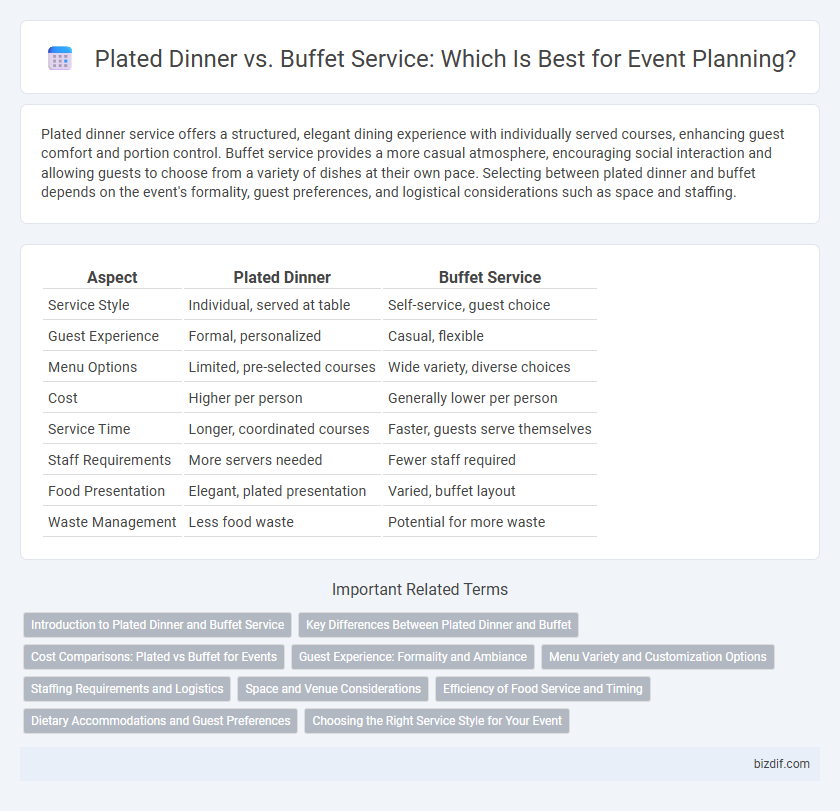Plated dinner service offers a structured, elegant dining experience with individually served courses, enhancing guest comfort and portion control. Buffet service provides a more casual atmosphere, encouraging social interaction and allowing guests to choose from a variety of dishes at their own pace. Selecting between plated dinner and buffet depends on the event's formality, guest preferences, and logistical considerations such as space and staffing.
Table of Comparison
| Aspect | Plated Dinner | Buffet Service |
|---|---|---|
| Service Style | Individual, served at table | Self-service, guest choice |
| Guest Experience | Formal, personalized | Casual, flexible |
| Menu Options | Limited, pre-selected courses | Wide variety, diverse choices |
| Cost | Higher per person | Generally lower per person |
| Service Time | Longer, coordinated courses | Faster, guests serve themselves |
| Staff Requirements | More servers needed | Fewer staff required |
| Food Presentation | Elegant, plated presentation | Varied, buffet layout |
| Waste Management | Less food waste | Potential for more waste |
Introduction to Plated Dinner and Buffet Service
Plated dinner service involves guests being served individually plated meals at their tables, ensuring a structured and elegant dining experience ideal for formal events. Buffet service allows guests to serve themselves from a variety of dishes displayed on tables, promoting a casual, flexible dining atmosphere suitable for large gatherings. Each approach affects event flow, guest interaction, and menu customization in distinct ways tailored to event goals.
Key Differences Between Plated Dinner and Buffet
Plated dinner service offers guests individually served meals with controlled portion sizes, enhancing elegance and ensuring dietary preferences are accommodated. Buffet service allows for a self-serve format where guests select from various dishes, promoting variety and flexibility but requiring more space and staff management. Cost considerations differ as plated dinners often incur higher labor costs, while buffets can reduce service expenses but may increase food waste.
Cost Comparisons: Plated vs Buffet for Events
Plated dinners typically incur higher costs due to increased labor for serving and plated presentation, with average prices ranging from $25 to $50 per person. Buffet service often offers cost savings by reducing staff requirements and allowing guests to serve themselves, with prices generally between $15 and $35 per person. Event planners must weigh these cost differences against desired guest experience and service style when budgeting for catering.
Guest Experience: Formality and Ambiance
Plated dinner service offers a structured, elegant dining experience emphasizing formality and personalized guest attention, enhancing ambiance with meticulous presentation. Buffet service provides a more casual, interactive atmosphere where guests enjoy diverse food choices and flexibility, fostering a lively social environment. Selecting between plated and buffet impacts the event's tone, catering style, and overall guest satisfaction significantly.
Menu Variety and Customization Options
Plated dinner service offers limited menu variety as guests typically choose from a preset selection, allowing for precise portion control and personalized plating that enhances customization. Buffet service provides extensive menu variety, enabling guests to sample multiple dishes and accommodate diverse dietary preferences, but it may lack tailored portion sizes. Event planners must balance the desire for broad menu options with the level of customization and formality required for the occasion.
Staffing Requirements and Logistics
Plated dinner service demands a higher staff-to-guest ratio, with servers assigned to individual tables to ensure seamless, timely meal delivery and personalized attention. Buffet service requires fewer servers but more support staff for food replenishment, station maintenance, and crowd management to maintain order during self-service. Logistics for plated dinners involve precise coordination of courses and timing, while buffets necessitate strategic layout planning to optimize flow and reduce wait times.
Space and Venue Considerations
Plated dinner service requires more space per guest due to the need for dedicated seating and table settings, making it ideal for venues with spacious dining areas and well-defined seating arrangements. Buffet service optimizes space by allowing flexible guest movement and accommodating larger crowds in venues with limited seating capacity. Venue layouts with narrow aisles or limited circulation space may favor plated service to maintain orderly flow and comfort.
Efficiency of Food Service and Timing
Plated dinner service offers precise timing and controlled portion sizes, enhancing efficiency in food delivery and minimizing wait times for guests. Buffet service allows for greater flexibility and faster self-service, accommodating larger groups with varied dining paces but may lead to longer lines and potential food replenishment delays. Choosing between plated and buffet options depends on event size, guest preferences, and desired service speed.
Dietary Accommodations and Guest Preferences
Plated dinner service offers precise control over dietary accommodations by allowing customized meal options tailored to individual guest preferences, including allergies and specific dietary restrictions. Buffet service provides a wide variety of food choices, enabling guests to select dishes that suit their tastes and dietary needs, though it may pose cross-contamination risks for severe allergies. Event planners must weigh the importance of personalized dietary care against the flexibility and casual atmosphere provided by buffet setups.
Choosing the Right Service Style for Your Event
Plated dinner service offers a structured and elegant dining experience, ideal for formal events where timing and presentation are priorities. Buffet service provides guests with variety and flexibility, making it suitable for casual or large-scale gatherings where social interaction is encouraged. Selecting the right service style depends on factors like event formality, guest preferences, and logistical considerations.
Plated dinner vs Buffet service Infographic

 bizdif.com
bizdif.com